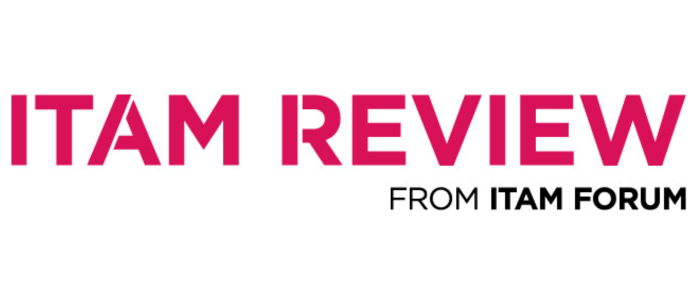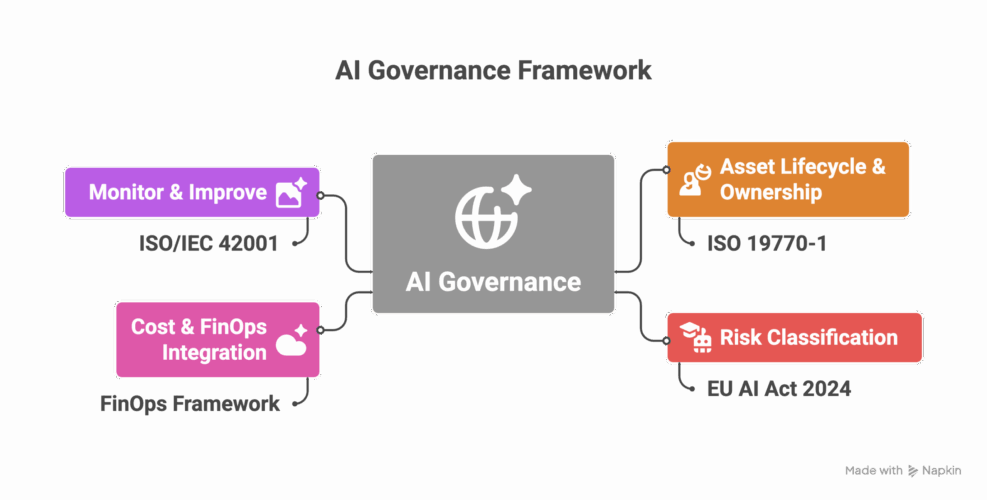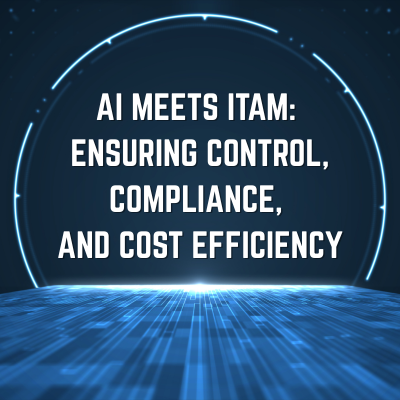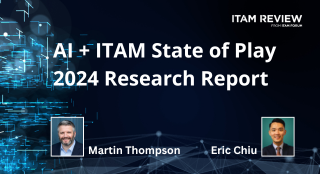AI in ITAM: Insightful Signals from the Front Line
During our Wisdom Unplugged USA event in New York in March 2025, we engaged ITAM professionals with three targeted polling questions to uncover their current thinking on Artificial Intelligence—what concerns them, where they see opportunity, and what role they believe ITAM should play in the future of AI governance. The results offer a valuable window into where the ITAM profession stands today and where it needs to evolve.
1. Governance, Risk, and the Unfinished Business of AI Regulation
The dominant theme emerging from the question “What aspect of AI are you most uncertain about?” was clear: governance. Practitioners want clarity. Who owns AI oversight? What guardrails exist? How do we ensure AI decisions remain transparent and accountable?
Security and risk followed closely, with worries around misinformation (“hallucinations”), data leakage, and trustworthiness. These are real concerns. They underscore the urgent need for frameworks that marry ITAM’s traditional strengths in oversight with new digital realities.
2. Skills for the AI-Augmented ITAM Professional
When asked which uniquely human skills should be prioritised, five core competencies stood out:
1. Critical Thinking & Problem Solving: AI is powerful, but not infallible. ITAM professionals must remain the human filter that spots what the machine misses.
2. Communication: From stakeholder briefings to translating AI outputs into business insights, clear communication remains essential.
3. Strategic Thinking: AI doesn’t set the strategy—it follows it. ITAM leaders must help define the direction.
4. Prompting & Data Literacy: Knowing how to ask the right questions of AI is becoming a key differentiator. Think of prompting as the new querying.
5. Adaptability: Perhaps most importantly, embracing AI not as a threat, but as an enabler, will separate those who thrive from those who fall behind.
This is not about becoming a data scientist. It’s about augmenting our existing expertise with new capabilities that make us more effective, not less. Your ally, not your replacement, as discussed here.
3. ITAM’s Role in AI Governance: Clarity Emerging Through Complexity
When asked about ITAM’s role in AI regulation, responses reflected a mix of forward-thinking vision and some uncertainty. Encouragingly, four distinct opportunities emerged:
1. Asset Discovery & Classification: AI tools are assets. We already know how to find, catalogue, and track them.
2. Cost & Usage Oversight: ITAM’s lens on cost, access, and consumption makes it a natural partner in governance.
3. Cross-Functional Collaboration: There’s growing recognition that ITAM must work alongside Legal, HR, and Risk to shape compliance policies.
4. Data Stewardship: We are the custodians of asset data. That responsibility extends to AI systems, especially when decisions rely on their outputs.
However, a few respondents voiced skepticism, questioning whether AI regulation truly falls within ITAM’s remit. This signals the need for further education and perhaps a recalibration of ITAM’s identity in a post-AI world.
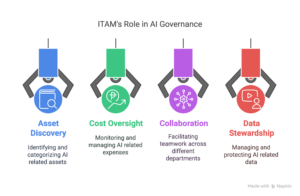
Final Thoughts: From Gatekeepers to Enablers
If there’s one takeaway from this polling exercise, it’s this: AI isn’t coming to replace ITAM, it’s coming to challenge us to evolve. Those who embrace a proactive, value-adding role—who can govern with nuance, communicate with clarity, and adapt with purpose—will shape the next chapter of ITAM. I propose managing AI like an asset.
As a profession, we now have the chance to lead—not just in managing assets but in leading IT management.
POLL SUMMARY – MANAGING AI AS AN ASSET, WISDOM UNPLUGGED, NEW YORK, MARCH, 2025.
Q. What aspect of AI are you most curious or uncertain about right now?
Top 5 Common Themes Identified:
- Governance & Regulation – There’s significant concern about how AI is governed, who controls it, and the existence (or lack) of regulatory frameworks.
- Security & Risk – Participants were worried about AI-related risks like misinformation (hallucinations), data breaches, and general AI reliability.
- Job Impact & Automation- There’s uncertainty around AI’s impact on employment and the extent to which it will automate tasks or roles.
- IT Asset Management (ITAM) Integration – How AI can be applied within ITAM, there is real interest in practical deployment.
- Functionality & Technical Understanding – Curiosity about how AI actually functions, particularly natural language processing and its rapid developme
Q: Which skills should ITAM professionals prioritise today to effectively collaborate with AI and remain successful? In other words, what uniquely human skills should we focus on strengthening for the future?”
Top 5 Common Themes Identified:
- Critical Thinking & Problem Solving – Human oversight is vital in identifying flaws, biases, and misalignments in AI-generated output. Professionals must maintain judgment and reasoning to use AI responsibly.
- Communication & Interpersonal Skills – Being able to clearly articulate insights from AI and foster cross-functional collaboration remains a uniquely human and indispensable skill.
- Strategic Thinking & Governance – AI collaboration requires professionals to think strategically—guiding AI usage within frameworks that align with organisational goals and ensure responsible governance.
- Prompting & Data Literacy – Mastery in shaping inputs (prompts, queries) and interpreting outputs is becoming a critical skill set. Those who understand how to “ask the right questions” will unlock more value from AI tools.
- Adaptability & Human-AI Synergy – Future-proof ITAM professionals are agile learners who embrace AI as a tool—adapting workflows and mindsets to integrate AI into everyday operations effectively.
Q: What role can IT Asset Management (ITAM) play in helping an organisation effectively manage compliance with AI regulations?
Top 5 Common Themes Identified:
- AI Asset Discovery, Tracking & Classification – ITAM can serve as a foundation for AI compliance by mapping and classifying AI tools and users across the organisation—enabling visibility that is critical for regulatory audits and accountability.
- Cost, Access & Usage Oversight – By monitoring financial and usage data, ITAM can provide a vital lens on resource allocation and financial compliance, as well as flag unauthorised or high-risk use of AI systems.
- Collaboration with Legal, HR & Governance Bodies – ITAM isn’t a siloed function—it can support regulatory compliance by collaborating with legal, HR, risk, and procurement teams to ensure the AI governance framework is actionable and cross-functional.
- Data Stewardship & Reporting – ITAM can function as an intelligence hub—providing trusted data on AI tool use, aligning it with regulatory frameworks and supporting informed compliance decisions.
- Skepticism or Unclear Role – Some still view regulatory compliance as outside ITAM’s core scope, underscoring a need to define and evolve ITAM’s role in emerging AI governance practices.
Can’t find what you’re looking for?
More from ITAM News & Analysis
-
Microsoft Pricing Changes: EA Customers Face Price Increases
From 1st November 2025, Microsoft will remove all tiered pricing for Online Services under the Enterprise Agreement. This means all customers renewing or purchasing new Online Services after this date, will receive standard level A pricing ... -
Microsoft Q4: Cloud and AI Results Drive Record Revenue
On 30th July 2025, Microsoft released its much-anticipated FY25 Q4 earnings report. The results follow a surprisingly strong Q3, which exceeded the expectations of some of the most optimistic investors. The latest Q4 results continue with ... -
The Future of ITAM
As an ITAM Industry Analyst, I’m often asked what ITAM’s future looks like. This can be a tough question to answer because when it comes to the future, there are endless possibilities. Often, it seems, some ...
Software Licensing Training
Similar Posts
-
Eight steps towards AI governance
I delivered our “Managing AI as an Asset” training course the day before the Wisdom conference last week. Thank you to those who attended and provided feedback. It will be available on the LISA platform before ... -
AI Governance Through an ITAM Lens: Treat AI as a Status Change, Not a New Asset
Managing AI in the enterprise is a team sport. In this article, I want to explore specifically what ITAM brings to the table as we enter the AI era. As I’ve mentioned in previous articles on ... -
AI meets ITAM: Ensuring Control, Compliance, and Cost Efficiency
ITAM teams face new challenges in tracking AI software, managing dynamic licensing models, and controlling cloud costs. Without a clear strategy, organisations risk overspending, compliance issues, and a lack of visibility into AI-driven assets. Parpreet Singh ... -
AI and ITAM: State of Play 2024 Research Report
In 2024, the ITAM Forum and General Interfaces conducted a global survey (On behalf of the ITAM Forum’s AI+ITAM Working Group) targeting ITAM practitioners, executives, and stakeholders to explore the growing influence of AI on the ...
